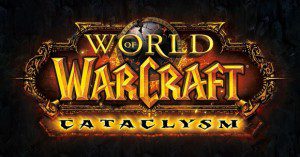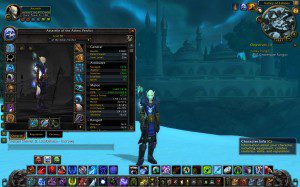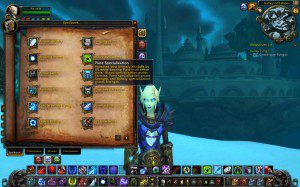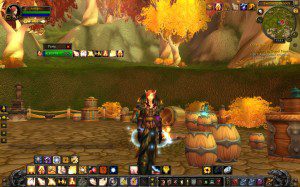With weeks to go before Blizzard unleashes its third expansion for its wildly popular MMORPG World of Warcraft, they sought to introduce to current players of their massive online community to some of the new mechanics they are adding to the game.

Some called it upgrading, others called it nerfing, but in the end, the game currently enjoyed by over 12,000,000 subscribers underwent some massive changes, forever altering the course of their online experience. This is just one player’s tale of the changes, and how they changed the course of his game playing experience from the moment the Open Beta was announced.
I would like to preface this review by stating that I embody three different, yet very similar, player types within the WoW community: first off, I am a casual raider. This means that my play experience is less influenced by such popular, and commonplace, tactics like min/maxing (for extreme damage output) and more focused on having a good time. I have coaches and friends who help me from being a total loss, but I know I’m underperforming by the standards of the serious raider. Fortunately, I am quite happy with my current 7-9K DPS (damage per second output) and being one of the top PUGs on my server.
Second, I do not have a bevy of toons, all at max level with full tier-10 gear. I have 2 geared 80 characters- a Paladin and a Death Knight. As such, much of my musings on the patch will be centered around those classes. But since both are very popular choices (and a lot of the “grief” over 4.0.1 was shunted on the former), I hope to give an accurate representation of what has happened to them.
Third, I do RP. It falls in line with my first point, and also explains a lot of WHY I am a casual player. Grinding for gear and achieves gets very old very fast for me, and I prefer the chance to stretch my legs and interact with my fellow players. Fortunately, my guild raids alongside RP, and we are currently 11/12 in ICC 10, which is something of a rarity among RP guilds on an RP server.
So hopefully this explains a good deal of the tone and “flavor” of this review in the end. I apologize for not being able to give a “hard-core” gamers review on the changes in 4.0.1, but I am an casual player enjoying time in a fantastic world to escape the drudgery of daily life. WoW is not my entire world, just a part of it, and one I am very content with. I know I share this opinion with many other players. So, without further ado, I present the “Everyman’s Guide to 4.0.1.”
Mechanics Changes
Players who logged in on patch day were greeted with a number of sweeping changes to the gameplay experience. In Blizzard’s words, they wanted to streamline the game, and add a challenge that many felt was missing within the 3.3.5 edition of the game, in place through the final year of Wrath of the Lich King. In particular, they wanted to improve the idea of “rotation” mechanics for DPS classes, increase the challenges involved with threat generation for tanks and add spice to the sometimes dull aspect of healing. In other words, they wanted to make players play their classes again. This was a common complaint from many of the players of “Vanilla” WoW and “The Burning Crusade” years- they felt the class mechanics were overly simplified and were diluting the game. In particular, there were many chances for certain classes to become “OP” (over-powered) or “Faceroll” (where the player needed only two or three skills to function- essentially you could hotlink your attacks to random keys, slam your face on the keyboard, and roll it side to side and still do maximum damage output).
Patch 4.0.1 changed all that, for better or worse. In the months leading up to patch day, many players in the open beta for Cataclysm reported significant changes to popular classes that tweaked mechanics and made them far more difficult to properly play. One of the biggest changes came to the Paladin class, long considered “OP” or “FotM” (flavor of the month) by many players. In particular, it centered around Blizzards desire to make their rotation “more punishing” by eliminating the “FCFS” (first come first served- hit whatever attack lights up first) mentality and forcing the players to keep track of new resources (in this case, Holy Power) in order to maximize damage, or take a massive hit to DPS if the chance is missed/hit too early. Of course, with Paladins being one of the most popular classes in the game at the time, the forums lit up with criticism, angry remarks and a few examples of “rage quitting” (where players simply left the game because their class had been “nerfed”).
On the flip side of this, certain other classes experienced substantial boosts to their damage output. Mages, shaman, warlocks and shadow priests all received either boosts to their passive damage or tweaked skills that were easy to “spam” (hit rapidly) for massive bursts of damage. This made these classes more potent in raids and instance runs, but also upset some of the balance within Player Vs Player content, where it was entirely possible for one of the class specs, (for example, the Elemental Shaman,) to “one shot” (instantly kill) most other classes of similar gear and player experience levels. Cries of being OP shifted from melee to casters, and the game went on.
Tanking also received significant changes: first off the skill of Defense (translating to dodging, blocking and parry increases) was eliminated in favor of tweaks to it’s component skills. Another major elimination: passive threat (which aided them in getting enemies to focus on just the tank), which many tanks enjoyed immensely to that point. Put simply, they no longer generated huge amounts of threat right off the bat, and it was entirely possible (and very easy) for a tank to lose threat to a DPS or Healer player. This heralded the end to the common practice of “wait a few seconds for the tank to grab aggro then blitz your target” and was a bit of a return to the older days of WoW, as it requires for DPS classes to now perform “crowd control” and keep single targets off Healers and more focused on either the tank or themselves (or in other cases, to restrict their own damage output for the sake of the party) . However annoying stealing threat is from a tank, fortunately thanks to higher damage outputs it is very easy for a skilled DPS to drop a single heroic target now in a few hits and thus take some strain off the tank.
Healers were not exempt from these changes either. Much like with DPS, Paladin healers now found themselves facing a strange, new territory with multiple heals and a more “triage” like setting where they are now forced to choose heals based on need, timing and raid awareness, something other healer classes have been dealing with for the past few years. However, don’t think that other classes have it easy now, or have an advantage on the poor, beleaguered plate-casters. Whereas before, the job of healing mostly focused on spamming a few spells over and over and maybe tossing an AoE (area effect) or HoT (heal over time) spell around as needed, now healers must be acutely aware of their own stats, casting times and heal outputs. One poorly selected spell can kill a tank and wipe a raid, and simply spamming the most powerful heals will result in the healer going OOM (out of mana) very quickly. To be a skilled healer, it is now crucial for players to think on their feet and be able to adapt to quickly changing scenarios, and to, again, be very aware of their stats and resources. Mana drops very fast, the sheer number of healing options can be daunting, and in many cases, add-ons are becoming more necessary in this new world (I downloaded Healium just to make my job a bit easier, and I’m still overwhelmed in certain boss encounters).
This said, the amount of actual skill now needed to properly perform in dungeons and raids makes grinding them fun again, which is something many veteran players now will need to do up until Cataclysm finally is released. But more on that later on.
Up next: Stat and Talent revisions




